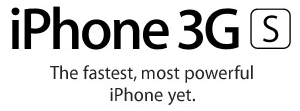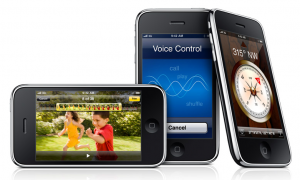iPhone 3GS Review
 Evolution not revolution seems to be the quote of choice amongst reviewers of the iPhone 3GS, but I think it sells the device somewhat short. While it’s easy to dismiss minor bumps to speed, in practice it feels like a different phone. I’ve now been using the device for a little over two weeks, going about my daily routine and putting it through its paces, so in what ways does it differ from the 3G, and why do I think some reviewers are selling it short?
Evolution not revolution seems to be the quote of choice amongst reviewers of the iPhone 3GS, but I think it sells the device somewhat short. While it’s easy to dismiss minor bumps to speed, in practice it feels like a different phone. I’ve now been using the device for a little over two weeks, going about my daily routine and putting it through its paces, so in what ways does it differ from the 3G, and why do I think some reviewers are selling it short?
The Basics
 The test unit for this review is a black 32Gb iPhone 3GS on the UK’s O2 network. Externally, it’s identical to a 3G but for silver text on the back (it’s a muted grey on the 3G). Using identical dimensions and interface points to the 3G is a very smart move by Apple, it means all your docks, covers and other accessories will still work. Certainly my car dock, speaker dock and sync cable all work with both my 3G and 3GS. This means that migrating it simple and hassle free. Likewise, on first sync I simply restored from my 3G backup and all my apps came across with me.
The test unit for this review is a black 32Gb iPhone 3GS on the UK’s O2 network. Externally, it’s identical to a 3G but for silver text on the back (it’s a muted grey on the 3G). Using identical dimensions and interface points to the 3G is a very smart move by Apple, it means all your docks, covers and other accessories will still work. Certainly my car dock, speaker dock and sync cable all work with both my 3G and 3GS. This means that migrating it simple and hassle free. Likewise, on first sync I simply restored from my 3G backup and all my apps came across with me.
In fact, the only slight hassle I’ve had came after that first sync where the addition of the Compass app meant I had to rearrange all my home screens. In the grand scheme of things, this really is a minor inconvenience.
[ad]
Speed
Yes the rumours were true, the “S” in 3GS stands for speed, and it’s clear to see why. Side by side with a 3G the 3GS is noticeably faster. Loading times are greatly reduced but it’s the general responsiveness and smoothness that impresses most. On the 3G, when you flick the home screen left to bring up the new Spotlight features, there’s an ever so slight but still perceptible stutter. On the 3GS, it’s silky smooth. This smoothness carries through to all the apps, both Apple provided and not. Scrolling through my contacts list is far smoother than on the 3G, and it’s the same for emails, photos, damn near everything. For me, the “S” in 3GS would be more appropriate if it stood for “Smooth”.
There are also little differences that add up to a whole heap of saved time. One example is the number of pages Safari can store in its cache. On the 3G you will notice that returning to Safari from another app leads to the page being reloaded, even where the preview is still in place. On the 3GS, this seems to happen far less often. So while the 3GS may only be a couple of seconds faster loading a web page, in practice it needs to do so far less often, meaning that you save a substantial amount of time overall (especially when not on WiFi).
Probably the most telling aspect of the 3GS is that it makes using the 3G feel a bit laboured. It’s definitely a strange feeling to come away with, as I’ve always seen the iPhone as being performant. Compared to the Nokia N95 the iPhone 3G replaced, it was unbelievably responsive (having said that, the N95 is one of the most frustrating devices I’ve ever used). However, after living with the 3GS and then going back to a 3G, you really start to notice little stutters and pauses, slight hesitations, that have been present all this time, but never really noticed. If you want an iPhone experience similar to the one in the much debated advertisements, then it’s the 3GS that comes closest.
Imaging
 The other headline feature of the 3GS is the improved camera. Having come from a Nokia N95, the camera really felt like a let down on the iPhone 3G. In fact, I went from one frustrating camera on a phone to another. On the N95 the photos were of very high quality, 5 megapixels and very sharp. The downside was that the camera app took so long to start up, focus and save images that you could rarely photograph anything you wanted to. The iPhone 3G was the complete opposite, I could take 3 photos on the iPhone 3G in the same amount of time it took to take on on the N95, but the quality simply wasn’t there.
The other headline feature of the 3GS is the improved camera. Having come from a Nokia N95, the camera really felt like a let down on the iPhone 3G. In fact, I went from one frustrating camera on a phone to another. On the N95 the photos were of very high quality, 5 megapixels and very sharp. The downside was that the camera app took so long to start up, focus and save images that you could rarely photograph anything you wanted to. The iPhone 3G was the complete opposite, I could take 3 photos on the iPhone 3G in the same amount of time it took to take on on the N95, but the quality simply wasn’t there.
Apple made a very smart move with the 3GS in my opinion. In stead of chasing the pack with a ridiculous amount of megapixels, they’ve refined the camera interface to make sure people can actually use it. The addition of autofocus has helped with photo sharpness no end, but it’s the interface and inner workings that have allowed Apple to trump the competition. Touching an area on the screen, which is essentially a viewfinder when in the camera app, focuses the lens on that area. But not only that, it adjusts the white balance and exposure of the shot as well, using the focused area as a spot for metering. In practice, you point your phone at a scene and then touch the bit of the scene that you want to look good, the phone takes care of the rest.
 Considering how complicated other cameras, let alone camera phones, makes this process, the iPhone’s interface really is refreshingly simple, and equally brilliant. You don’t need to explain exposure, white balance or focusing to people for them to take really nice photos. The technophobe, or those who aren’t well versed in the subtleties of photography will get better pictures out of this phone than any DSLR or point and shoot, purely because of the interface.
Considering how complicated other cameras, let alone camera phones, makes this process, the iPhone’s interface really is refreshingly simple, and equally brilliant. You don’t need to explain exposure, white balance or focusing to people for them to take really nice photos. The technophobe, or those who aren’t well versed in the subtleties of photography will get better pictures out of this phone than any DSLR or point and shoot, purely because of the interface.
A fringe benefit of autofocus being added to the camera is that clean and sharp photos can now be taken of close objects. So expect to see a slew of bar-code and text recognition apps that actually work hitting the app store.
Apple’s “do it right” philosophy can be seen in their implementation of video recording as well. Reports have confirmed that the iPhone 3GS is capable of recording video at 720p, rather than the more more conservative 640 x 480 we get. While Apple know they can provide a smooth user experience with a 3MP camera, they also know they can do it with 640 x 480 video. just because they can do something, it doesn’t necessarily mean they should. And I’d question anyone who’d want to sacrifice the experience we currently get with video on the iPhone for a slightly higher resolution. Recording video is much like taking a photo, automatic orientation, focusing, white balance and exposure is all still active and you can record until you run out of memory. You can see a sample video I took here. I thought this video would be a particularly good test as it includes changing brightness levels as well as fast movement.
And the smooth user experience doesn’t end there, once you’ve taken the video it appears in your camera roll and you can flick between videos just as you’d expect. You can also crop videos (i.e. remove the beginning or end) and then send them as an MMS message or email or upload them to You Tube or Mobile Me. This seamless ability to shoot a video, edit it and then upload it directly to You Tube will inevitably lead to a new wave of “on the spot” coverage of events. And best of all, it all works beautifully.
3GS Only Apps
There’s been a lot written about the potential for the 3GS to create a two tier system in the app store (obviously glossing over the fact that we already have a two tier system for the iPhone and iPod Touch) because of the 3GS’s enhanced graphical capabilities. At the moment, I don’t think this will be the factor that causes the iPhone app market to split. In the risk vs reward calculations app developers will have to go through, the risk of excluding at least two thirds of your potential customers for the reward of slightly improved visuals is unlikely to be appealing.
What might be tempting for app developers in the 3GS is the magnetometer. Looking at apps like Nearest Tube (video of Nearest Tube in action here), the potential of this feature is massive. And what’s more, this isn’t something that can be easily scaled down to cater for the 3G and original iPhone users (unlike graphics). You’ll note that the Nearest Tube application is 3GS only. To say that augmented reality is the future of hand-held devices is an understatement, and it’s not really possible without a direction aware device.
Miscellaneous
There are a host of other features of the 3GS that warrant mention, so I’ll run through them quickly.
- Battery Life – Within 10% of the 3G, and I’d say slightly worse. The 3GS supports the ability to display the remaining battery charge as a percentage, and I believe this may be tainting my view of the phone’s battery life somewhat. Perception is everything.
- Signal Strength – Identical to the 3G in my experience. The same number of bars in the same locations as the iPhone 3G. 3G network connection in the same areas as well.
- Voice Controls – Now this was a surprise, because it worked reasonably well. I typically have a problem with voice controls because of my accent, but the app worked reasonably well. Of course, it’s all relevant, and most voice controls simply don’t work for me at all, so a 75% success rate feels like a win.
- Tethering – This isn’t something I’ve tested due to O2’s extortionate tethering charges. It’s unfortunate that networks feel the need to cripple new technologies by making them prohibitively expensive (not that tethering is new, but O2 feel the need to charge for this feature on the iPhone, but no other handsets).
- Compass – The compass app itself is fairly basic, expect to see improved versions with additional features in the app store soon. As I touched on above, it’s the underlying technology that makes this exciting.
Negatives
This review has had a positive tilt so far, so it’s only fair to point out some of the negatives. Firstly, and the elephant in the room, is the price. This is not a cheap phone, in fact, in the UK it’s one of the most expensive phones you can buy. Prohibitive upgrade costs also mean that this is one iPhone many people will pass up. Is it worth the money? Well, you’ll be getting the best version of the best phone available, and perhaps it would surprising if you didn’t have to pay a premium for that privilege. It’s galling to many iPhone 3G owners that the discounted upgrade rates offered to draw original iPhone owners up to the 3G have not been offered here, meaning you have not only pay for the handset but also buy out the remaining 6 – 12 months of your contract (buying out the contract alone could cost you a maximum of £880). This is the case with every other phone with every other carrier though, so O2 can’t be singled out for criticism in this regard (tethering is another matter).
In use, I’ve noticed a couple of slight glitches in third party applications. When starting Peggle, for example, the logo initially jumps around the screen before settling down. These problems are certainly rare though, and I’ve not encountered an app that didn’t work.
A slightly disappointing aspect of the 3GS is the sensitivity of the magnetometer to interference. This is particularly irksome when the iPhone is sitting in my car dock, where it’s impossible to follow the recommended course of action of moving the phone in a figure of eight. There’s also been some occurences where the Google Map app seems to think I’m driving in a crabbing fashion along the road. The Navigon app exhibits no such problems, and also succeeds in keeping the phone cooler in use and actually uses less battery.
Speaking of heat, the reports of the iPhone 3GS becoming very hot should not be ignored. I’ve only experienced this while using Google maps and having the phone in the car dock. The combination of using the GPS, magnetometer, playing music, charging the battery and having the phone exposed to the sun (through the windshield) seemed to create a “perfect storm” of heat generation. After 45 minutes, the handset was extremely hot, almost too hot to hold. This is something Apple should keep an eye on, but I can’t really blame the phone for becoming hot in those particular circumstances (I’d be intrigued to see what sort of situation produced the scorched white iPhone 3GSs we’ve seen.
Summary
Summarising the iPhone 3GS is difficult. In short, it feels like not just an iPhone, but the iPhone. This is simply how the iPhone should be. Fast, smooth and very reassuring. Many will question the value of upgrading, but for me, it’s a no-brainer. If you use your current iPhone a lot, as I do, you’ll really appreciate that all these little gains in speed, and numerous refinements really add up to a very pleasurable experience. I’d rather not have to pay the amount being asked, but after using the 3GS for a couple of weeks now, it would be near impossible to go back to the 3G.
The iPhone 3GS is available exclusively on the O2 network in the UK and can be picked up from either Apple, O2 or Carphone Warehouse stores, but don’t bother with Carphone Warehouse because they provide one of the poorest retail experiences I’ve ever had the misfortune to encounter, they really are a bunch of amateurs. See this post on iPhone availability to see how you can check stock levels from the comfort of your own home.

